跨文化交际版
- 格式:docx
- 大小:20.46 KB
- 文档页数:19


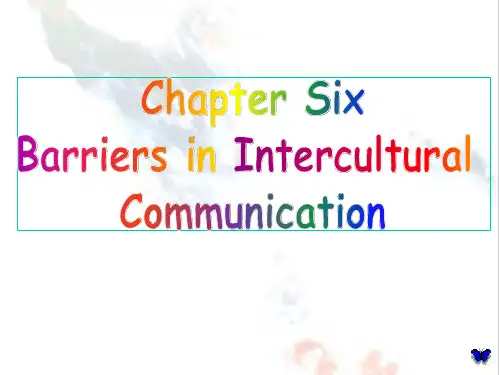
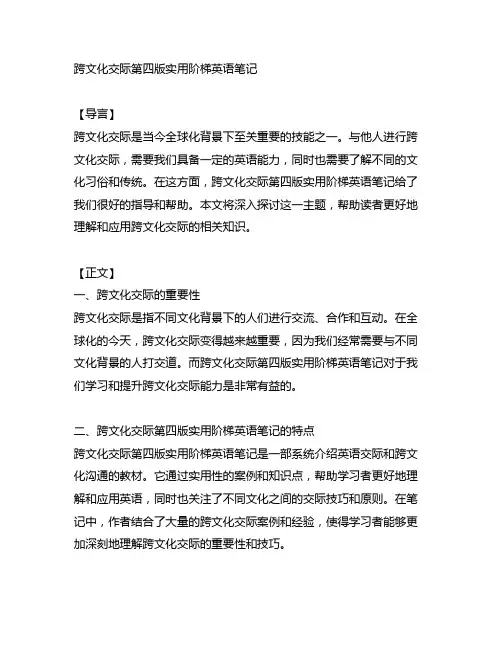
跨文化交际第四版实用阶梯英语笔记【导言】跨文化交际是当今全球化背景下至关重要的技能之一。
与他人进行跨文化交际,需要我们具备一定的英语能力,同时也需要了解不同的文化习俗和传统。
在这方面,跨文化交际第四版实用阶梯英语笔记给了我们很好的指导和帮助。
本文将深入探讨这一主题,帮助读者更好地理解和应用跨文化交际的相关知识。
【正文】一、跨文化交际的重要性跨文化交际是指不同文化背景下的人们进行交流、合作和互动。
在全球化的今天,跨文化交际变得越来越重要,因为我们经常需要与不同文化背景的人打交道。
而跨文化交际第四版实用阶梯英语笔记对于我们学习和提升跨文化交际能力是非常有益的。
二、跨文化交际第四版实用阶梯英语笔记的特点跨文化交际第四版实用阶梯英语笔记是一部系统介绍英语交际和跨文化沟通的教材。
它通过实用性的案例和知识点,帮助学习者更好地理解和应用英语,同时也关注了不同文化之间的交际技巧和原则。
在笔记中,作者结合了大量的跨文化交际案例和经验,使得学习者能够更加深刻地理解跨文化交际的重要性和技巧。
三、如何有效利用跨文化交际第四版实用阶梯英语笔记在使用跨文化交际第四版实用阶梯英语笔记时,我们可以从以下几个方面进行学习和应用:1. 学习常见的交际技巧和原则:跨文化交际需要我们了解对方文化的基本礼貌和行为规范。
通过学习笔记中的案例和技巧,我们可以更加深入地了解不同文化之间的交际技巧,避免造成不必要的误会和冲突。
2. 加强英语口语和书面表达能力:跨文化交际需要我们具备一定的英语表达能力。
跨文化交际第四版实用阶梯英语笔记通过大量的练习和案例,帮助我们提升英语口语和书面表达能力,使得我们能够更加自如地与他人交流。
3. 建立跨文化交际的意识和能力:跨文化交际不仅仅是语言交流,更重要的是文化之间的理解和尊重。
在使用跨文化交际第四版实用阶梯英语笔记时,我们需要培养跨文化交际的意识和能力,学会在交流中尊重对方的文化差异,避免产生不必要的文化冲突。


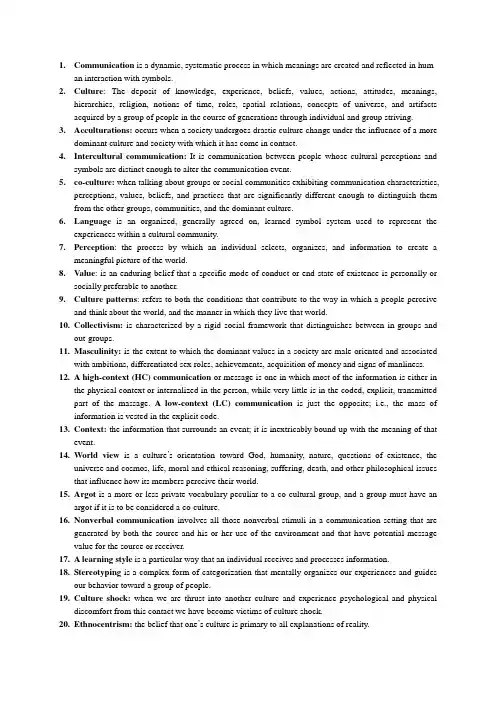
munication is a dynamic, systematic process in which meanings are created and reflected in human interaction with symbols.2.Culture: The deposit of knowledge, experience, beliefs, values, actions, attitudes, meanings,hierarchies, religion, notions of time, roles, spatial relations, concepts of universe, and artifacts acquired by a group of people in the course of generations through individual and group striving.3.Acculturations: occurs when a society undergoes drastic culture change under the influence of a moredominant culture and society with which it has come in contact.4.Intercultural communication:It is communication between people whose cultural perceptions andsymbols are distinct enough to alter the communication event.5.co-culture: when talking about groups or social communities exhibiting communication characteristics,perceptions, values, beliefs, and practices that are significantly different enough to distinguish them from the other groups, communities, and the dominant culture.nguage is an organized, generally agreed on, learned symbol system used to represent theexperiences within a cultural community.7.Perception: the process by which an individual selects, organizes, and information to create ameaningful picture of the world.8.Value: is an enduring belief that a specific mode of conduct or end-state of existence is personally orsocially preferable to another.9.Culture patterns: refers to both the conditions that contribute to the way in which a people perceiveand think about the world, and the manner in which they live that world.10.Collectivism:is characterized by a rigid social framework that distinguishes between in-groups andout-groups.11.Masculinity: is the extent to which the dominant values in a society are male oriented and associatedwith ambitions, differentiated sex roles, achievements, acquisition of money and signs of manliness. 12.A high-context (HC) communication or message is one in which most of the information is either inthe physical context or internalized in the person, while very little is in the coded, explicit, transmitted part of the massage. A low-context (LC) communication is just the opposite; i.e., the mass of information is vested in the explicit code.13.Context: the information that surrounds an event; it is inextricably bound up with the meaning of thatevent.14.World view is a culture’s orientation toward God, humanity, nature, questions of existence, theuniverse and cosmos, life, moral and ethical reasoning, suffering, death, and other philosophical issues that influence how its members perceive their world.15.Argot is a more or less private vocabulary peculiar to a co-cultural group, and a group must have anargot if it is to be considered a co-culture.16.Nonverbal communication involves all those nonverbal stimuli in a communication setting that aregenerated by both the source and his or her use of the environment and that have potential message value for the source or receiver.17.A learning style is a particular way that an individual receives and processes information.18.Stereotyping is a complex form of categorization that mentally organizes our experiences and guidesour behavior toward a group of people.19.Culture shock: when we are thrust into another culture and experience psychological and physicaldiscomfort from this contact we have become victims of culture shock.20.Ethnocentrism: the belief that one’s culture is primary to all explanations of reality.21.Seven characteristics of culture affect communication: learned, transmitted from generation togeneration, based on symbols, dynamic, integrated, ethnocentric, adaptive.22.Belief: our conviction in the truth of something. Learned and subject to cultural interpretation andcultural diversity.23.Individualism:refers to the doctrine, spelled out in detail by the seventeenth. The single mostimportant pattern in the US.24.Hofstede’s Value Dimensions:four parts: individualism-collectivism, uncertainty avoidance, powerdistance, and masculinity and femininity.25.Culture differs in their attitudes toward: individualism and collectivism, uncertainty avoidance,power distance, masculinity and femininity, human nature, the perception of nature, time, activity, relationships, context, formality and informality, assertiveness and interpersonal harmony.26.Religious Similarities: sacred writings, authority, traditional rituals, speculation, ethics.27.Five religious orientations: Christianity, Judaism, Islam, Hinduism, Buddhism.28.the family we are born into the family of orientation and take a spouse the family of procreation.29.problems of translation and equivalence:vocabulary or lexical equivalence, idiomatic and slangequivalence, grammatical-syntactical equivalence, experiential-cultural equivalence, conceptual equivalence.30.The use of argot reflects a co-culture’s need to have a language that permits them to 1.sharemembership,2. participate in their social and cultural communities,3. identify themselves and their place in the universe, 4. communicate with one another about their own social realities.31.Functions of communication: repeating, complementing, substituting, regulating, contradicting.32.The study of how movement communicates is called kinesics. Kinesic cues are those visible bodyshifts and movements that can send messages about 1.our attitude toward the other person 2. our emotional state 3. our desire to control our environment.33.Eyes serve six communication functions: 1. indicates degree of attentiveness, interest, and arousal 2.help intiate and sustain intimate relationships 3. influence attitude change and persuasion 4. regulate interaction 5. communicate emotions 6. define power and status relationships 7. assume a central role in impression management.34.kinds of vocalizations: vocal characterizers, vocal qualifiers, vocal segregates.。

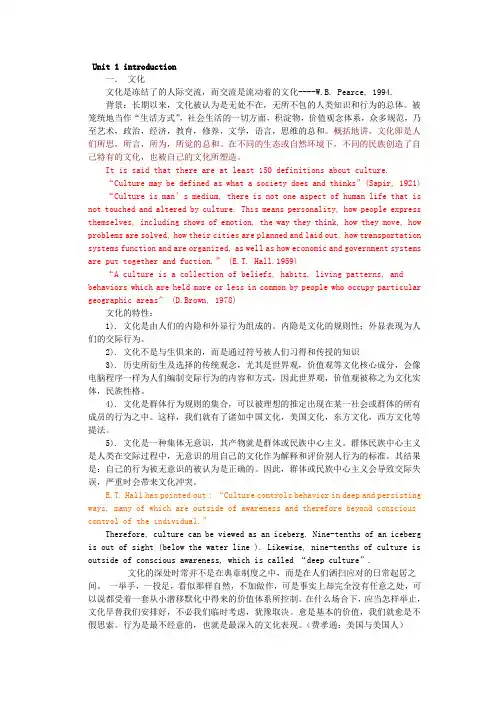
Unit 1 introduction一.文化文化是冻结了的人际交流,而交流是流动着的文化----W.B. Pearce, 1994.背景:长期以来,文化被认为是无处不在,无所不包的人类知识和行为的总体。
被笼统地当作“生活方式”,社会生活的一切方面,积淀物,价值观念体系,众多规范,乃至艺术,政治,经济,教育,修养,文学,语言,思维的总和。
概括地讲,文化即是人们所思,所言,所为,所觉的总和。
在不同的生态或自然环境下,不同的民族创造了自己特有的文化,也被自己的文化所塑造。
It is said that there are at least 150 definitions about culture.“Culture may be defined as what a society does and thinks”(Sapir, 1921) “Culture is man’s medium, there is not one aspect of human life that is not touched and altered by culture. This means personality, how people express themselves, including shows of emotion, the way they think, how they move, how problems are solved, how their cities are planned and laid out, how transportation systems function and are organized, as well as how economic and government systems are put together and fuction.” (E.T. Hall,1959)“A culture is a collection of beliefs, habits, living patterns, and behaviors which are held more or less in common by people who occupy particular geographic areas” (D.Brown, 1978)文化的特性:1). 文化是由人们的内隐和外显行为组成的。
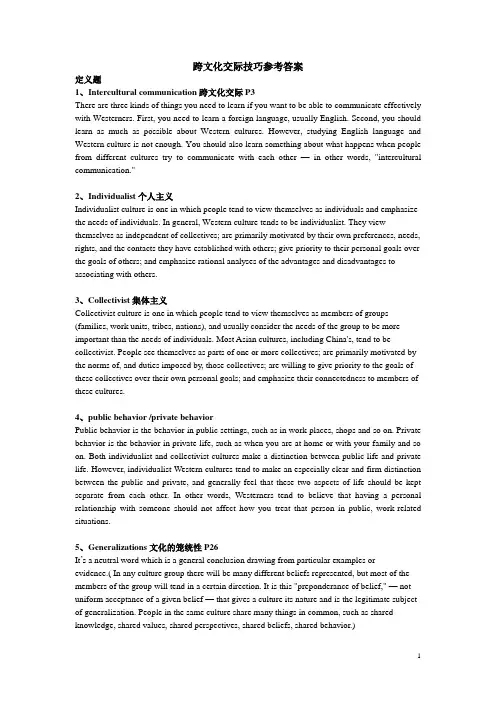
跨文化交际技巧参考答案定义题1、Intercultural communication跨文化交际P3There are three kinds of things you need to learn if you want to be able to communicate effectively with Westerners. First, you need to learn a foreign language, usually English. Second, you should learn as much as possible about Western cultures. However, studying English language and Western culture is not enough. You should also learn something about what happens when people from different cultures try to communicate with each other —in other words, "intercultural communication."2、Individualist个人主义Individualist culture is one in which people tend to view themselves as individuals and emphasize the needs of individuals. In general, Western culture tends to be individualist. They view themselves as independent of collectives; are primarily motivated by their own preferences, needs, rights, and the contacts they have established with others; give priority to their personal goals over the goals of others; and emphasize rational analyses of the advantages and disadvantages to associating with others.3、Collectivist集体主义Collectivist culture is one in which people tend to view themselves as members of groups (families, work units, tribes, nations), and usually consider the needs of the group to be more important than the needs of individuals. Most Asian cultures, including China's, tend to be collectivist. People see themselves as parts of one or more collectives; are primarily motivated by the norms of, and duties imposed by, those collectives; are willing to give priority to the goals of these collectives over their own personal goals; and emphasize their connectedness to members of these cultures.4、public behavior /private behaviorPublic behavior is the behavior in public settings, such as in work places, shops and so on. Private behavior is the behavior in private life, such as when you are at home or with your family and so on. Both individualist and collectivist cultures make a distinction between public life and private life. However, individualist Western cultures tend to make an especially clear and firm distinction between the public and private, and generally feel that these two aspects of life should be kept separate from each other. In other words, Westerners tend to believe that having a personal relationship with someone should not affect how you treat that person in public, work-related situations.5、Generalizations文化的笼统性P26It‟s a neutral word which is a general conclusion drawing from particular examples or evidence.( In any culture group there will be many different beliefs represented, but most of the members of the group will tend in a certain direction. It is this "preponderance of belief," — not uniform acceptance of a given belief — that gives a culture its nature and is the legitimate subject of generalization. People in the same culture share many things in common, such as shared knowledge, shared values, shared perspectives, shared beliefs, shared behavior.)6、Stereotypes老套思路P26It is a derogatory word. It means that image, idea, character that has become fixed or standardized in a conventional form without individuality and is therefore false and shallow.( A way of thinking that does not acknowledge internal difference within a group, and does not acknowledge exception to its general rules or principles. These stereotypes are often based on accurate information but the problem is that stereotypes blind us to other, equally important aspects of a person's character or behavior. Stereotypes may have been created by direct experience with only one or two people from a particular group. Others are probably based on the second-hand information and opinion, output from the mass media, and general habits of thinking; they may even have been formed without any direct experience with individuals from the group. Yet many people are prepared to assume that stereotype is an accurate representation of all members of a specific group.)7、Hierarchy不同的等级权利P33Different in rank and power----equalityEvery society has hierarchy to some degree. In other words, some people have higher rank and more power than others, perhaps because they are older, stronger, wealthier, or have some kind of official position. On the other hand, however, most modern societies also believe that equality is a virtue, at least to some extent. So each culture needs to find its own balance between hierarchy and equality.1) Westerners generally have less respect for seniority — age, position and so forth — than would be the case in a collectivist culture.2) Western societies often try to limit the power of government officials.3) Westerners tend to have a somewhat suspicious and even negative view of power and authority.8、Culture shock文化冲击P36Culture shock is a feeling of being confused and overwhelmed by life in another culture. People who experience culture shock often feel fatigued, impatient and irritable. They may also begin trying to avoid interaction with foreigners, and even become increasingly critical and hostile toward them. Foreigners in China sometimes experience culture shock — and so do Chinese who go to live in other countries.9、Projected cultural similarity P48Projected cultural similarity is the tendency to assume that people from other cultures basically think and feel more the same way we do. In other words, we sometimes assume that while foreigners may look different, dress differently, and speak different languages, "inside we are all more or less the same". People from different culture assume they understand each other instead of asking each other what they think. Because they each expect the other person to react more or less the same way they would, they don't check to see whether or not the other person actually has the same feelings and reactions they would.10、loose culture and tight cultureLoose culture doesn‟t demand a high degree of conformity. In loose cultures, people have a relatively wide range of views as to what is considered normal behavior. They also tend to berelatively tolerant of behavior that does not conform to cultural norms. And there is less pressure on individuals within the same culture to behave the same way most other people in the culture do. Tight culture: expect a relatively high degree of conformity. There is a clear consensus as to what is and is not acceptable behavior and there is more pressure on people to conform to the norms of the culture.Here is an example of how people deal with people who are born left-handed. In tight cultures, children who favor their left hand are encouraged or even forced to use their right hand instead, and the percentage of left-handed people in the adult population is much smaller.11、Ethnocentrism 民族优越感P59"Ethnocentrism" is the tendency to think of one‟s own culture as being at the center of the world and identify with one‟s in-group and to evaluate out-groups and their members according to its standards; in other words, to assume that one‟s own culture's way of thinking and acting is more natural, normal, and correct than the way people from other cultures think and act, and tend to view one‟s own cultural values and ways of doing things as more real, or as the …right‟ and natural values and ways of doing things.12、In-groups and out-groups P70In-Groups: “In-groups”are the people we have the most in common with and identify most closely with, such as our family, classmates, or co-workers. We also have larger in-groups such as people who are from our own region, religious group, ethnic group, or nation. In-groups are groups of people about whose welfare we are concerned, with whom we are willing to cooperate without demanding equitable returns, and separation from whom leads to discomfort or even pain. Out-groups: out groups are those groups of people who we do not identify with---people from other families, regions, ethnic groups, or nations. Out-groups are groups of people about whose welfare we are not concerned, and groups with whom we require an equitable return in order to cooperate.13、war stories P80The term “war stories” originally referred to the kinds of stories soldie rs would tell after experiences in battle. Now “war stories” refers more generally to any stories people tell after strange or stressful experiences, including stories about unusual encounters with foreigners.14 low context/ high context1.Low context: the way westerners communicate tends to be relatively explicit and direct. In other words, Westerners tend to put most of their ideas and feelings into words, and then state their ideas and feelings plainly and openly. It‟s generally considered a good thing to get to the point and say what you mean, and it‟s largely the speaker‟s responsibility to ensure that his/her massage is stated in a way that is clear and easy to understand. --low context, people are expected to pay more attention to the words used in communication than to context in which things are said. They expect others to …take them at their words‟-to believe that what they say is what they mean.2.High context: in collectivist cultures, people tend to communicate in a way that is more indirect and subtle, and listeners are expected to take more responsibility for inerpreting messages correctly. -High context, people are expected to pay much attention to the context in which communication takes place- who the speaker is, where and why the conversation is taking place, body language, and so forth-and when people interpret what others mean, they often give more weight to the context than to the actual words said. People in high context often view direct, explicit communication as unsophisticated or even rude.问答题1、Why would intercultural communication be more difficult than the communication between people from the same culture?(Why is it hard to learn a foreign culture?)先定义intercultural communication1)Some stumbling blocks2)Assuming more cultural similarities leads to misunderstanding3)Language difference4)Misinterpreting verbal communication and body language from other country5)Stereotype and preconceptions6)Evaluate before really understanding7)Interact with foreigners stressfully and suffer from culture shock8)Tend to generalize or simplify9)Tend to define groups by a few key characteristic10)Assume everyone is similar2、What are some differences between an individualist culture and a collectivist one?Are all Westerners individual ? Are all Chinese collectivist?先定义individualist 和collectivist(1) Westerners tend to believe that people should rely on themselves as much as possible- and they usually expect other people to do the same. In contrast, people in collectivist cultures generally feel they have a right to expect help from other members of their groups(family, classmates, and so forth), and they also tend to feel they have an obligation to help other members of their groups.(2) Westerners generally feel that the rights of individuals should not be subordinated to the needs of a larger group, or at least that individuals should have to right to decide for themselves whether to sacrifice their benefit for the sake of the group.(3) Westerners tend to believe that individuals should make decisions for themselves and that individuals should take credit and responsibility for what they have personally done.(4) A final difference lies in the way people in difference cultures view the idea of “individualism”. Westerners tend to view individualism as a good thing. In English, the word “individualism”has no negative connotation. In fact, its connotation is somewhat positive. In contrast, the Chinese term for “individualism” , often has a somewhat negative connotation, and is sometimes used as a synonym for “selfishness”.3、What are the different virtues Chinese and Americans emphasize most?先要定义一下virtueChinese: formality/ hierarchy/ industriousness/ being filial/ hard work/ modesty/ thrifty Americans: activity-dominant/ equality/ motivation based on achievement/ the world is material rather than spiritual/ optimistic/ individualist/ materialism/ success/ humanitarianism4、How do Western cultures view the relationship between public and private life?先定义public: work, national duty; private: home, family, personal friendshipsWestern cultures tend to make an especially clear and firm distinction between the public and private, and generally feel that these two aspects of life should be kept separate from each other. In other words, westerners tend to believe that having a personal relationship with someone should not affect how you treat that person in public, work-related situations. (In fact, some westerners try to avoid mixing work and play completely, and keep their circle of work acquaintances quite separate from their circle of personal friends)Of course, personal relationships do make a difference in how people in the west treat each other, even in public settings. However, the wall between public and private life tends to be somewhat higher in the individualist west than it is in collectivist cultures.5、What are stereotypes? Why are they a problem?It is a derogatory word. It means that image, idea, or chance that has become fixed or standardized in a conventional form without individuality and it is therefore false and shallow. A way of thinking that does not acknowledge internal difference within a group, exception to its general rules or principles. These stereotypes are often based on accurate information but the problem is that stereotypes blind us to other equally important aspects of a person‟s character or behavior. Stereotypes may have been created by direct experience with only one or two people from a particular group. Others are probably based on the second hand information and opinion outputfrom the mass media, and general habits of thinking; they may even have been formed without any direct experience with individuals from the group. Yet many people are prepared to assume that stereotype is an accurate representation of all members of a specific group.6、Try to think of several more generalization that can be made about important characteristics of Chinese culture.Collectivism: emphasis on the doctrine of the meanLarge power distance--hierarchyIntergroup harmony and avoidance of over conflict in interpersonal relationsBelief in the naturalness, necessity and inevitability of hierarchyInequality based on achievement, especially academic, moral and finance achievementBelief that “the judgment of wise people” is a better way to regulate life than rigid artificial laws. People exist “in and through relationship with others”Academic emphasis on memory, attention to details, and lengthy homeworkBrain washThe golden meanHypocriticalThe judgment of wise people/law8、What are the similarity and difference between Projected Cultural similarity and Ethnocentrism? P48两个定义Projected Cultural similarity and EthnocentrismThe similarity: both of them can not be avoided or overcame in intercultural communication. These two phenomena show that every country or nation considers their own culture as the center.The difference: E is taking one‟s own culture norms as the standard by which to judge people of other cultures. PCS is assuming that people of other cultures view things the same way you do. PCS: People have the tendency to assume that other people from other cultural background basically think and feel more or less the same way as they do.E: People have the tendency to think their culture has the superiority to others‟ and assume that their own culture‟s way of thinking and acting is more natural, normal and correct than the way people from other cultures‟ thinking and act.9、Comment on “Do unto others what you would have them do unto you. “P49先定义Projected cultural similarityThe sentence means that it‟s better not to do things to others what you don‟t want others do to you. This behavior shows the phenomena” projected cultural similarity”. In our cultural system, if you don‟t like thing done to you, you just don‟t impose on others. It‟s a kind of virtue. But from the aspect of PCS, people just assume people from other cultures view things the same way we do. What we think is right, we consider others will think it‟s right, too. However, it just doesn‟t work out like that. Because of different cultural background, we have different interpretations of everything happened. We can not expect others o think or act the same as we do.10、Why would people project cultural similarity? P49定义Projected cultural similarityIt is hard for people to imagine a perspective different from their own. It is effected by human nature, people are accustomed to self-centered. When they communicate with foreigners, they usually assume that foreigners are similar to us. As we grow up and learn what is right and wrong, truth and false, normal and abnormal, and so forth, we naturally learn to view the world as our culture view it. The only way to solve PCS is communication.11、comment on conformity in western cultures p56定义Loose cultures do not demand a high degree of conformity. In loose cultures, people have a relatively wide range of views as to what is considered normal behavior.Tight cultures, in contrast, expect a relatively high degree of conformity. There is a clear consensus as to what is and is not acceptable behavior, and there is more pressure on people to conform to the norms of the culture.Chinese culture is tight culture, and western cultures are loose culture. So conformity in western cultures is less in Chinese culture.Weak conformity12、What factors lead to looseness or tightness in culture? P54定义(1)The degree of change in the population--- the more people move, the looser and more individualist a society tends to be.(2)The density of the population.: small dense societies tend to be collectivist, hence tighter. Large dense society tend to be more complex, hence not quite so tight---melting pot.(3)The number of choices available in society--- the more choices available, the more room there is for individualism.(4)strict registration/registered permanent residence13、why does ethnocentrism cause difficulty in intercultural communication? P59定义ethnocentrismBecause we naturally feel that the ways and ideas of our culture are more natural and correct than those of other cultures. So we tend to use the norms of our own culture---such as the idea of what is good/bad, right/wrong, normal/abnormal—as standards when we judge the behavior of people from other cultures. So when we encounter foreigners who behave or think in ways that differ from our cultural norms, we too quickly tend to judge these other ways as strange, wrong or bad.14、Why are in/out-groups a problem in intercultural communication?P70定义We generally have more positive feelings toward members or our in-groups than we do toward outsiders. We trust insiders more. We tend to have a stronger sense of obligation to insiders. We feel it‟s right to help insider more than we help outsiders. We tend to judge in-groups and out-groups by different standards. To insiders, more generous but to outsiders, more critical, suspicious, more harsh judgments.So the tie of goodwill and trust between in-groups and out-groups are often relatively weak, and they break easily when there is conflict or misunderstanding.15、How do Chinese people treat in-group and out-group in line with culture back? P77定义There is a difference between the inside and the outside. Chinese generally have a high sense of loyalty and obligation to their in-groups, and will often go to great lengths to help people they consider members of their in-groups; however, they feel less obligation to outsiders.Chinese often view outsiders who come to china as guests., and give them much special treatment. In part, this is because Chinese view guests as a kind of in-group, and tend to treat in-group members very well.16、Never a borrower or a lender be. P79定义individualismAs it is firstly a famous American saying.This sentence means that ii is best to not lend money to other people and not to borrow from other people. When we lend or borrow something, we risk losing both things and the friendship with that person. To begin with, t is because westerners are in individualist cultures. In such kind culture, individualists tend to view themselves as individuals and to emphasize the needs of individuals. Individualists feel less obligation to others, whether they are in-groups or out-groups. Secondly, because of their characteristics, their individualism, western people tend to be very independent and self-reliant. They will always solve their problems by themselves. So they don‟t want others to rely on them. either.17、Characteristics of war stories P82The term “war stories”originally referred to the kinds of stories soldiers would tell after experiences in battle. Now, “war stories”refers more generally to any stories. People tell after strange or stressful experiences, including stories about unusual encounters with foreigners.War stories about intercultural communication tend to share several characteristics:(1)One reason we tell war stories is to get reassurance that our interpretation of the encountermakes sense.(2)In war stories, we generally portray ourselves as the hero or victim, and we often paint theforeigner as the “bad guy”.(3)We generally tell war stories to people who are likely to sympathize with us, usually peoplefrom our own culture rather than outsiders.(4)As we tell war stories, we often generalize from one specific experience to groups offoreigners as a whole.。
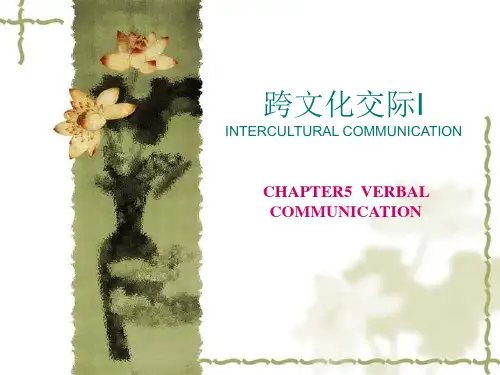
跨文化交际英文版 IMB standardization office【IMB 5AB- IMBK 08- IMB 2C】C r o s s–c u l t u r a l c o m m u n i c a t i o nThesis statement: This paper is mainly talking about the culture differences between several countries.Outline:Chapter 1: Language and culture in communicationChapter2: Culture shockChapter3: What’s in a name?Chapter4: Social interactionChapter 5: Roles and relationsChapter6: Non-verbal communicationChapter 7: In other words.Chapter 8: From a primitive Tribe to a Global VillageConclusionChapter 1: Language and culture in communicationThere is no denying the fact that out daily lives depend largely on communication, without it we can’t know each other. So, we should come to realize that communication is of great importance.What is communication?In total, communication can be divided into two parts; they are verbal communication and non-verbal communication. However, different people hold different opinions about communication. In general, if there is communication, there must have 4 cases: there are at least two or more people, some contact between communicators, a language shared by communicators, an exchange of information has taken place. I just take the fist one for example. Suppose there is one person, there can’t be communication. Otherwise, he may talk to himse lf.Communication not just exist in human-beingsThere are five kinds of communications they are human communication, animal communication, human-animal communication, human machine communication, machine communication. So, Animals and machines can also communicate with each other.For human beings, how can we communicate with each other?Experts say that there are various kinds of communication. Nowadays, there are different kinds of tools for us to communicate .For people we can use telephone and computer to communicate with each other. By them, finally we can receive message.What is social situationWhen there are two or more people gather to do a job or an activity, then it creates a social situation. That is to say, an individual working alone can not constitute a social sA social situation may have two definitions. One is given by the community, and the other by the participants. Finally, we should notice that being polite plays a crucial role in social situation.Chapter2: Culture shockWe should not only know what communication is but we should know what culture shock is.In contemporary society, as our country is developing faster and faster, more and more foreigners will come to our country. Communicating with foreigners is an interesting thing. However, there is no doubt that it can easily cause misunderstanding which is called culture shock. There are several kinds of culture shock.Hospitality: First of all, in Britain, hospitality can not be judged by whether hosts put the food into your dishes, in there, everyone has own dishes, everyone helps themselves. By contrast, in our country, when we have guests, hosts may put the food into guest’s dishes to show their hospitality, so this is different.Politeness: When it comes to this word, in many case, foreigners were described as being polite than Chinese. For example, when we finish work, foreigners may say thank you to us, although it is out duties. However, for Chinese, they seldom say thank you because they think someone who serves them are their duties.What’s more, when we get along with foreigners, we should avoid asking their salaries, jobs and religious and so on. For the young, it’s all right to ask their ages, for the adults, this question is not allowed, especially for the females. But in china, these questions are allowed.In conclusion, when we face these culture shocks, it is better to keep a cool head, and then make an adjustment toward it, finally, we can cope with it. As time goes by, we can adapt it. For example, American Jewish and Israel, the two groups are equal and integration. Both groups have positive attitudes toward one another. So I am sure that after learning this unit, we can know a lot about culture shock and can easily communicate with foreigners.Chapter 3: What’s in a name?The topic of unit three is “what’s in a name?” As is known to all, the English name is different from the Chinese name .The Chinese name consists of family name and given name ,with family name put first. But in contrast, the family name of English name is coming last. Most English people have three names. The last name , or surname is the family name .This is the family name of the father and is given to all his children. And the first name is given to the child at birth, which is called “given name”. And another name used to refer to them is Christian name.However, Chinese name can give all sorts of information about a Chinese people .they may give the address, the birthday ,and also tell us about the family relationship, ethic groups, sex and the parents’ expectation for their children. At the same time, in Chinese the use of kin terms is closely related to age politeness, such as that children are expected to call an old lady, Granny and call a male adult who is older than their fathers, elder uncle. The appropriate and extend use of kin term according to age is taken as reflecting good manners.Chapter4: Social interactionWhat is “social interaction”. It is the topic of unit four. Social interaction is an important way of human existence, and it is different from other animals’ communication. And it’s meaningful. Different countries have different social interactions. Many Chinese people tend to ask age, marital status, and even salary when they meet each other first. To the Chinese people, these are open conversational topic. and Chinese people pay much attention to family life. So in their spare time, they will talk about the family member features as a common topic. It is so natural. And the salary is not a secret .and when a Chinese offers refreshments or drinks to his colleague, his colleague often declines the offer politely, because he don’t want to trouble the person who offers. And it also shows his politeness. But in western countries, if you ask the person who meet you first about these, they will feel so bad. They think it is not polite.Do you know how English native negotiate a time to meet .from the text I know that you may find their way of settling on a time is quite similar to our own, that is , normally one gives or suggests a time, then the other may find it is not suitable and suggest another time, and finally a time is fixed which suits both.Consequently, you can know from above, different countries have different habits.Chapter 7: In other words.Different languages cause some misunderstandingsThere are many countries that their language is the same. such as America , British, Canada, Australia,and so on, they all speak English, people from America and British speak different varieties of English. They usually find little difficulty in understanding each other.However, there are some differences which may cause some misunderstanding, because of profusion of synonyms that they use different words to refer to the same thing. But for other countries which do not speak English they hardly understand the idioms, for example “face the music” in America it means to accept the criticisms, unpleasant consequences, etc . it probably comes from the custom in some Western armies of punishing soldiers to the sound of beating drums, if a person who is come from China may comprehend that enjoy himself by listening to music. on the contrary,they can not understand the meaning of Chinese idioms.There are some similar in languagesWith the exception, both English and Chinese have many such idioms that refer to animals, and some animals have similar associations in both cultures: deer, for example , are bloodthirsty and cruel, ect . But some other animals have rather different associations, like dogs, in the eyes of English-speaking people,dog is loyal ,but in the eyes of Chinese it aways contains derogatory sense are seen rather differently from the way appear to us. About proverb, since human experiences and observations of the world are in many respect similar. in spit of the dissimilar cultural backgrounds of the Chinese and the English-speaking peoples, the number of proverbs or saying in two language that are equivalent or closely approximate is rather surprising.Swearwords is the taboo for every countriesEvery language contains a special group of taboo words which people avoid using because they find them embarrassing or offensive. In many languages, swearwords are taboo, this is generally true of both English and Chinese. In English, certain swearwords seem to be more offensive than others and consequently the social prohibition against their use is stricter.Chapter 8: From a primitive Tribe to a Global VillageAnimals might have astonishing ways of showing their emotions andfeelings.This unit takes us back in to history, inviting us to reflect upon how man has extended his limbs and senses by using new technologies. Nowadays, the technologies are so advanced that communication over long distance can be done in a split of a second. People all over the world are living, quite literally, in a global village. In the textbook, we have learned that animals might have astonishing ways of showing their emotions and feelings. The way different kinds of animals behave, have fascinated great minds since Plato and AristotleCommunication is covering everywhereOne point that is beyond doubt is that our ancestors were extremely handicapped --- in comparison with us now --- in communication. From the Stone Age, to the present day, over2,000,000 years, man has done his best to extend himself in order to improve his way of communication. Writing, printing technology, postal services, telegraph, telephone, radio, picture communication, television, computer and laser technology, internet --- these have extended man’s mouth, eyes, ears, hands, legs, in short the whole body beyond a house, a village, a county, a province, a country, an ocean, a continent, and even beyond the mother earth to the moon and the Mars. Going global is great, but an entirely different tone was heard: Globalization is a menace to mankind. Globalization will make the powers more powerful but the weak is weaker and the poor is poorer.ConclusionDifferent countries have their own cultures, so it causes the different cultures .Consequently, sometimes the people come from different places may cause some misunderstandings. After learning this textbook we can get along well with people all over the world.Finally, through this paper, we can learn more knowledge.。
跨文化交际技巧参考答案定义题1、Intercultural communication跨文化交际P3There are three kinds of things you need to learn if you want to be able to communicate effectively with Westerners. First, you need to learn a foreign language, usually English. Second, you should learn as much as possible about Western cultures. However, studying English language and Western culture is not enough. You should also learn something about what happens when people from different cultures try to communicate with each other — in other words, "intercultural communication."2、Individualist个人主义Individualist culture is one in which people tend to view themselves as individuals and emphasize the needs of individuals. In general, Western culture tends to be individualist. They view themselves as independent of collectives; are primarily motivated by their own preferences, needs, rights, and the contacts they have established with others; give priority to their personal goals over the goals of others; and emphasize rational analyses of the advantages and disadvantages to associating with others.3、Collectivist集体主义Collectivist culture is one in which people tend to view themselves as members of groups (families, work units, tribes, nations), and usually consider the needs of the group to be more important than the needs of individuals. Most Asian cultures, including China's, tend to be collectivist. People see themselves as parts of one or more collectives; are primarily motivated by the norms of, and duties imposed by, those collectives; are willing to give priority to the goals of these collectives over their own personal goals; and emphasize their connectedness to members of these cultures.4、public behavior /private behaviorPublic behavior is the behavior in public settings, such as in work places, shops and so on. Private behavior is the behavior in private life, such as when you are at home or with your family and so on. Both individualist and collectivist cultures make a distinction between public life and private life. However, individualist Western cultures tend to make an especially clear and firm distinction between the public and private, and generally feel that these two aspects of life should be kept separate from each other. In other words, Westerners tend to believe that having a personal relationship with someone should not affect how you treat that person in public, work-related situations.5、Generalizations文化的笼统性P26It’s a neutral word which is a general conclusion drawing from particular examples or evidence.( In any culture group there will be many different beliefs represented, but most of the members of the group will tend in a certain direction. It is this "preponderance of belief," —not uniform acceptance of a given belief —that gives a culture its nature and is the legitimate subject of generalization. People in the same culture share many things in common, such as shared knowledge, shared values, shared perspectives, shared beliefs, shared behavior.)6、Stereotypes老套思路P26It is a derogatory word. It means that image, idea, character that has become fixed or standardized in a conventional form without individuality and is therefore false and shallow.( A way of thinking that does not acknowledge internal difference within a group, and does not acknowledge exception to its general rules or principles. These stereotypes are often based on accurate information but the problem is that stereotypes blind us to other, equally important aspects of a person's character or behavior. Stereotypes may have been created by direct experience with only one or two people from a particular group. Others are probably based on the second-hand information and opinion, output from the mass media, and general habits of thinking; they may even have been formed without any directexperience with individuals from the group. Yet many people are prepared to assume that stereotype is an accurate representation of all members of a specific group.)7、Hierarchy不同的等级权利P33Different in rank and power----equalityEvery society has hierarchy to some degree. In other words, some people have higher rank and more power than others, perhaps because they are older, stronger, wealthier, or have some kind of official position. On the other hand, however, most modern societies also believe that equality is a virtue, at least to some extent. So each culture needs to find its own balance between hierarchy and equality.1) Westerners generally have less respect for seniority — age, position and so forth — than would be the case in a collectivist culture.2) Western societies often try to limit the power of government officials.3) Westerners tend to have a somewhat suspicious and even negative view of power and authority.8、Culture shock文化冲击 P369、Culture shock is a feeling of being confused and overwhelmed by life in another culture. People who experience culture shock oftenfeel fatigued, impatient and irritable. They may also begin trying to avoid interaction with foreigners, and even become increasingly critical and hostile toward them. Foreigners in China sometimes experience culture shock —and so do Chinese who go to live in other countries.9、Projected cultural similarity P4810、Projected cultural similarity is the tendency to assume that people from other cultures basically think and feel more the same way we do. In other words, we sometimes assume that while foreigners may look different, dress differently, and speak different languages, "inside we are all more or less the same". People from different culture assume they understand each other instead of asking each other what they think. Because they each expect the other person to react more or less the same way they would, they don't check to see whether or not the other person actually has the same feelings and reactions they would.10、loose culture and tight cultureLoose culture doesn’t demand a high degree of conformity. In loose cultures, people have a relatively wide range of views as to what is considered normal behavior. They also tend to be relatively tolerant of behavior that does not conform to cultural norms. And there is less pressure on individuals within the same culture tobehave the same way most other people in the culture do.Tight culture: expect a relatively high degree of conformity. There is a clear consensus as to what is and is not acceptable behavior and there is more pressure on people to conform to the norms of the culture.Here is an example of how people deal with people who are born left-handed. In tight cultures, children who favor their left hand are encouraged or even forced to use their right hand instead, and the percentage of left-handed people in the adult population is much smaller.11、Ethnocentrism 民族优越感P5912、"Ethnocentrism" is the tendency to think of one’s own cu lture as being at the center of the world and identify with one’s in-group and to evaluate out-groups and their members according to its standards; in other words, to assume that one’s own culture's way of thinking and acting is more natural, normal, and correct than the way people from other cultures think and act, and tend to view one’s own cultural values and ways of doing things as more real, or as the ‘right’ and natural values and ways of doing things.12、In-groups and out-groups P70In-Groups: “In-groups” are the people we have the most in common with and identify most closely with, such as our family, classmates,or co-workers. We also have larger in-groups such as people who are from our own region, religious group, ethnic group, or nation. In-groups are groups of people about whose welfare we are concerned, with whom we are willing to cooperate without demanding equitable returns, and separation from whom leads to discomfort or even pain. Out-groups: out groups are those groups of people who we do not identify with---people from other families, regions, ethnic groups, or nations. Out-groups are groups of people about whose welfare we are not concerned, and groups with whom we require an equitable return in order to cooperate.13、war stories P80The term “war stories” originally referred to the kinds of stories soldiers would tell after experiences in battle. Now “war stories” refers more generally to any stories people tell after strange or stressful experiences, including stories about unusual encounters with foreigners.14 low context/ high context1.Low context: the way westerners communicate tends to be relatively explicit and direct. In other words, Westerners tend to put most of their ideas and feelings into words, and then state their ideas and feelings plainly and openly. It’s generally considered a good thing to get to the point and say what you mean, and it’slargely the speaker’s responsibility to ensure that his/her massage is stated in a way that is clear and easy to understand. --low context, people are expected to pay more attention to the words used in communication than to context in which things are said. They expect others to ‘take them at their words’-to believe that what they say is what they mean.2.High context: in collectivist cultures, people tend to communicate in a way that is more indirect and subtle, and listeners are expected to take more responsibility for inerpreting messages correctly. -High context, people are expected to pay much attention to the context in which communication takes place- who the speaker is, where and why the conversation is taking place, body language, and so forth-and when people interpret what others mean, they often give more weight to the context than to the actual words said. People in high context often view direct, explicit communication as unsophisticated or even rude.问答题1、Why would intercultural communication be more difficult than the communication between people from the same culture(Why is it hard to learn a foreign culture)先定义intercultural communication1)Some stumbling blocks2)Assuming more cultural similarities leads to misunderstanding3)Language difference4)Misinterpreting verbal communication and body language fromother country5)Stereotype and preconceptions6)Evaluate before really understanding7)Interact with foreigners stressfully and suffer from cultureshock8)Tend to generalize or simplify9)Tend to define groups by a few key characteristic10)Assume everyone is similar2、What are some differences between an individualist culture anda collectivist oneAre all Westerners individual Are all Chinese collectivist 先定义individualist 和 collectivist(1) Westerners tend to believe that people should rely on themselves as much as possible- and they usually expect other people to do the same. In contrast, people in collectivist cultures generally feel they have a right to expect help from other members of their groups(family, classmates, and so forth), and they also tend to feel they have an obligation to help other members of their groups.(2) Westerners generally feel that the rights of individualsshould not be subordinated to the needs of a larger group, or at least that individuals should have to right to decide for themselves whether to sacrifice their benefit for the sake of the group.(3) Westerners tend to believe that individuals should make decisions for themselves and that individuals should take credit and responsibility for what they have personally done.(4) A final difference lies in the way people in difference cultures view the idea of “individualism”. Westerners tend to view individualism as a good thing. In English, the word “individualism”has no negative connotation. In fact, its connotation is somewhat positive. In contrast, the Chinese term for “individualism”, often has a somewhat negative connotation, and is sometimes used as a synonym for “selfishness”.3、What are the different virtues Chinese and Americans emphasize most先要定义一下virtueChinese: formality/ hierarchy/ industriousness/ being filial/ hard work/ modesty/ thriftyAmericans: activity-dominant/ equality/ motivation based on achievement/ the world is material rather than spiritual/ optimistic/ individualist/ materialism/ success/ humanitarianism 4、How do Western cultures view the relationship between public andprivate life先定义public: work, national duty; private: home, family, personal friendshipsWestern cultures tend to make an especially clear and firm distinction between the public and private, and generally feel that these two aspects of life should be kept separate from each other. In other words, westerners tend to believe that having a personal relationship with someone should not affect how you treat that person in public, work-related situations. (In fact, some westerners try to avoid mixing work and play completely, and keep their circle of work acquaintances quite separate from their circle of personal friends)Of course, personal relationships do make a difference in how people in the west treat each other, even in public settings. However, the wall between public and private life tends to be somewhat higher in the individualist west than it is in collectivist cultures. 5、What are stereotypes Why are they a problemIt is a derogatory word. It means that image, idea, or chance that has become fixed or standardized in a conventional form without individuality and it is therefore false and shallow. A way of thinking that does not acknowledge internal difference within a group, exception to its general rules or principles. Thesestereotypes are often based on accurate information but the problem is that stereotypes blind us to other equally important aspects of a person’s character or behavior.Stereotypes may have been created by direct experience with only one or two people from a particular group. Others are probably based on the second hand information and opinion output from the mass media, and general habits of thinking; they may even have been formed without any direct experience with individuals from the group. Yet many people are prepared to assume that stereotype is an accurate representation of all members of a specific group.6、Try to think of several more generalization that can be made about important characteristics of Chinese culture. Collectivism: emphasis on the doctrine of the meanLarge power distance--hierarchyIntergroup harmony and avoidance of over conflict in interpersonal relationsBelief in the naturalness, necessity and inevitability of hierarchy Inequality based on achievement, especially academic, moral and finance achievementBelief that “the judgment of wise people” is a better way to regulate life than rigid artificial laws.People exist “in and through relationship with others”Academic emphasis on memory, attention to details, and lengthy homeworkBrain washThe golden meanHypocriticalThe judgment of wise people/law8、What are the similarity and difference between Projected Cultural similarity and Ethnocentrism P48两个定义Projected Cultural similarity and EthnocentrismThe similarity: both of them can not be avoided or overcame in intercultural communication. These two phenomena show that every country or nation considers their own culture as the center. The difference: E is taking one’s own culture norms as the standard by which to judge people of other cultures. PCS is assuming that people of other cultures view things the same way you do.PCS: People have the tendency to assume that other people from other cultural background basically think and feel more or less the same way as they do.E: People have the tendency to think their culture has the superiority to others’ and assume that their own culture’s way of thinking and acting is more natural, normal and correct than the way people from other cultures’ thinking and act.9、Comment on “Do unto others what you would have them do unto you. “P49先定义Projected cultural similarityThe sentence means that it’s better not to do things to others what you don’t want others do to you. This behavior shows the phenomena”projected cultural similarity”. In our cultural system, if you don’t like thing done to you, you just don’t impose on others. It’s a kind of virtue. But from the aspect of PCS, people just assume people from other cultures view things the same way we do. What we think is right, we consider others will think it’s right, too. However, it just doesn’t work out like that. Because of different cultural background, we have different interpretations of everything happened. We can not expect others o think or act the same as we do.10、Why would people project cultural similarity P49定义Projected cultural similarityIt is hard for people to imagine a perspective different from their own. It is effected by human nature, people are accustomed to self-centered. When they communicate with foreigners, they usually assume that foreigners are similar to us. As we grow up and learn what is right and wrong, truth and false, normal and abnormal, and so forth, we naturally learn to view the world as our culture viewit. The only way to solve PCS is communication.11、comment on conformity in western cultures p56定义Loose cultures do not demand a high degree of conformity. In loose cultures, people have a relatively wide range of views as to what is considered normal behavior.Tight cultures, in contrast, expect a relatively high degree of conformity. There is a clear consensus as to what is and is not acceptable behavior, and there is more pressure on people to conform to the norms of the culture.Chinese culture is tight culture, and western cultures are loose culture. So conformity in western cultures is less in Chinese culture.Weak conformity12、What factors lead to looseness or tightness in culture P54 定义(1)The degree of change in the population--- the more people move, the looser and more individualist a society tends to be.(2)The density of the population.: small dense societies tend to be collectivist, hence tighter. Large dense society tend to be more complex, hence not quite so tight---melting pot.(3)The number of choices available in society--- the more choicesavailable, the more room there is for individualism.(4)strict registration/registered permanent residence13、why does ethnocentrism cause difficulty in intercultural communication P59定义ethnocentrismBecause we naturally feel that the ways and ideas of our culture are more natural and correct than those of other cultures. So we tend to use the norms of our own culture---such as the idea of what is good/bad, right/wrong, normal/abnormal—as standards when we judge the behavior of people from other cultures. So when we encounter foreigners who behave or think in ways that differ from our cultural norms, we too quickly tend to judge these other ways as strange, wrong or bad.14、Why are in/out-groups a problem in intercultural communicationP70定义We generally have more positive feelings toward members or our in-groups than we do toward outsiders. We trust insiders more. We tend to have a stronger sense of obligation to insiders. We feel it’s right to help insider more than we help outsiders. We tend to judge in-groups and out-groups by different standards. To insiders, more generous but to outsiders, more critical, suspicious,more harsh judgments.So the tie of goodwill and trust between in-groups and out-groups are often relatively weak, and they break easily when there is conflict or misunderstanding.15、How do Chinese people treat in-group and out-group in line with culture back P77定义There is a difference between the inside and the outside. Chinese generally have a high sense of loyalty and obligation to their in-groups, and will often go to great lengths to help people they consider members of their in-groups; however, they feel less obligation to outsiders.Chinese often view outsiders who come to china as guests., and give them much special treatment. In part, this is because Chinese view guests as a kind of in-group, and tend to treat in-group members very well.16、Never a borrower or a lender be. P79定义individualismAs it is firstly a famous American sentence means that ii is best to not lend money to other people and not to borrow from other people. When we lend or borrow something, we risk losing both things and the friendship with that person. To begin with, t is becausewesterners are in individualist cultures. In such kind culture, individualists tend to view themselves as individuals and to emphasize the needs of individuals. Individualists feel less obligation to others, whether they are in-groups or out-groups. Secondly, because of their characteristics, their individualism, western people tend to be very independent and self-reliant. They will always solve their problems by themselves. So they don’t want others to rely on them. either.17、Characteristics of war stories P82The term “war stories”originally referred to the kinds of stories soldiers would tell after experiences in battle. Now, “war stories” refers more generally to any stories. People tell after strange or stressful experiences, including stories about unusual encounters with foreigners.War stories about intercultural communication tend to share several characteristics:(1)One reason we tell war stories is to get reassurance that ourinterpretation of the encounter makes sense.(2)In war stories, we generally portray ourselves as the heroor victim, and we often paint the foreigner as the “bad guy”.(3)We generally tell war stories to people who are likely tosympathize with us, usually people from our own culture ratherthan outsiders.(4)As we tell war stories, we often generalize from one specificexperience to groups of foreigners as a whole.。